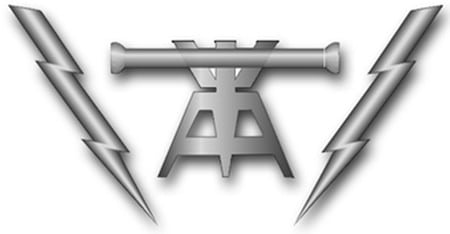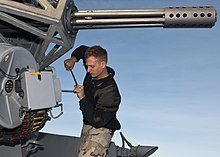
Fire controlman
| Fire Controlman | |
|---|---|
 Rating insignia |
|
| Issued by: United States Navy | |
| Type | Enlisted rating |
| Abbreviation | FC |
| Specialty | Weapons |
Fire Controlman (abbreviated as FC) is a United States Navy occupational rating.
Fire controlmen provide system employment recommendations; perform organizational and intermediate maintenance on digital computer equipment, subsystems, and systems; operate and maintain combat and weapons direction systems, surface-to-air and surface-to-surface missile systems, and gun fire control systems at the organizational and intermediate level; inspect, test, align, and repair micro/minicomputers and associated peripheral equipment, data conversion units, data display equipment, data link terminal equipment, print devices, and system related equipment; make analysis for detailed systems, computer programs, electronics, and electronic casualty control; and operate associated built-in and external test equipment; load, initialize, and run preprogrammed diagnostic, performance and testing routines for digital computer equipment, digital subsystems, digital systems, and overall combat systems.
FCs attend ATT (Apprentice Technical Training) and “A”-School at Naval Station Great Lakes; this course is roughly eight months long followed then by a “C”-school, based on one of the systems described below, which varies in length from 4 months to 8 months.
FCs typically operate weapon systems on-board surface combatant ships. They are trained in the repair, maintenance, operation and employment of weapons such as the Tomahawk Missile System, the Close-In Weapons System, the 5″/54 caliber Mark 45 gun weapon system and its associated MK86 or MK160 Gun Fire Control System, the MK92 Gun Fire Control System (on Frigates) the Sea Sparrow missile system, and the Harpoon Missile Systems. These include their associated computer and sensor packages. Their job is somewhat unique in that they are trained to troubleshoot and repair their systems, as well as operate them. These responsibilities are typically split up between different ratings for various types of electronic equipment.
In essence, they “pull the trigger”, to defend the ship from tactical threats, or to make an offensive strike against a hostile target.
Another area of responsibility for FCs is the Aegis weapon system, which includes one of the most powerful air-search radars, deployed at sea, in the world, the SPY-1, as well the MK99 Fire Control System, used for terminal guidance of Standard Missiles, and the Aegis Computer Suite.
The Origin
The rating was established in 1941. It was split off of the gunner’s mate rating. Fire controlman were highly skilled sailors responsible for the operation of various forms of range finding gear, and solving ballistic calculations to control the firing of the ship’s guns. These skills were originally employed primarily for naval gunfire support, and surface combat, but today fire controlman also play an extensive role in air warfare as well.
The fire controlman rating was later renamed “fire control technician” (FT), with specific sub-designators for gunnery (FTG), missiles (FTM) and submarines (FTU). Later the FTU designation was split into two specific sub-designations for torpedoes (FTG) and ballistic missiles (FTB).
In 1985 the name of this naval rating has changed back to fire controlman (FC). This allowed for the separation of the submarine rate FT from surface rate FC. FC was the original name of the rate through WWII when optic devices called theodolites were used. After WWII, when the duties changed to more technical things like radar and computers, the name was changed to fire control technician (FT). The FT name is now used exclusively for fire control personnel on submarines. The rating insignia is an coincidence or stereoscopic rangefinder, with two lightning bolts (called “sparks”) signifying the technical side. Until 1985 it had always been just the rangefinder without the lightning bolts.
FCs maintain the control systems used in aiming and firing weapons on all equipped ships. Complex computers, electronics, electrical, and hydraulic equipment is required to ensure the accuracy of guided missile and surface gunfire control systems. FCs are responsible for the operation, routine care, and repair of this equipment, which includes radars, computers, weapons-direction equipment, target-designation systems, gyroscopes, and rangefinders.[1]
The fire controlmans creed
I am a Fire Controlman, A Petty Officer of the United States Navy, my work is the operation and maintenance of the weapons aboard the fighting ships of the Navy,I am required to know, operate, and maintain intricate scientific precision instruments.
To do this, I must have a thorough knowledge of the work of an Electronics Technician, Machinist Mate, Gunners Mate, Machinery Repairman, Operations Specialist, and Engineman.
My aim in life is to know my job; to know everything that pertains to practical gunnery and ordnance.
As long as there is any operation or piece of equipment I do not fully understand, my job is not complete.
In the event of war, I must be prepared for any emergency.
I must be capable of and competent to fill my station, or perform any operation in the weapons department of my ship; to assume command of, spot, or control the fire of any battery.
In addition to being competent to perform any operation, I will strive to know my maintenance duties so well that I may maintain the battle efficiency of my ship, even on a darkened ship, under enemy fire. This to the end … THAT THE SHIP MAY FIGHT AS LONG AS SHE IS AFLOAT!
References
“Navy enlisted manpower and personnel classifications”. Bureau of Naval Personnel. US Navy. Retrieved 2007-01-11.


